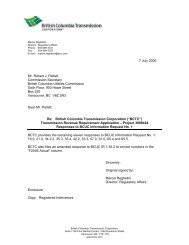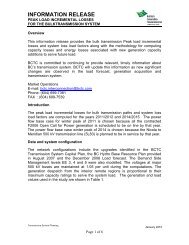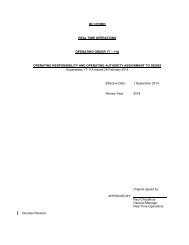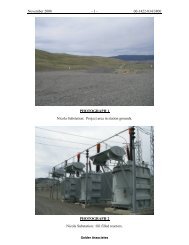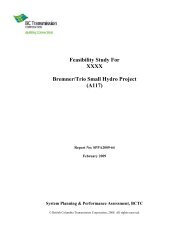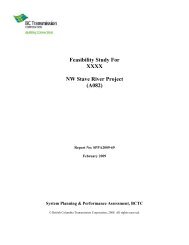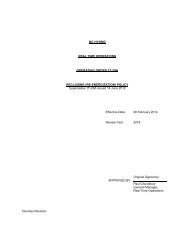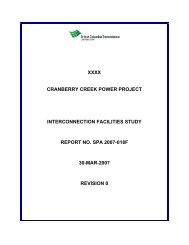Evidence on the Adequacy of First Nations Consultation - BC Hydro ...
Evidence on the Adequacy of First Nations Consultation - BC Hydro ...
Evidence on the Adequacy of First Nations Consultation - BC Hydro ...
Create successful ePaper yourself
Turn your PDF publications into a flip-book with our unique Google optimized e-Paper software.
12. ETHNOGRAPHIC ASSESSMENTS OF TERRITORIAL BOUNDARIES AND USE<br />
The several ethnographic works relating to <strong>the</strong> area have been a prime source <strong>of</strong> informati<strong>on</strong> and<br />
authoritative opini<strong>on</strong> <strong>on</strong> extent and use <strong>of</strong> <strong>the</strong> traditi<strong>on</strong>al territory <strong>of</strong> <strong>the</strong> Indians <strong>of</strong> <strong>the</strong> Columbia<br />
Plateau. A number <strong>of</strong> <strong>the</strong>se works have combined thorough and evaluative research into primary<br />
sources <strong>of</strong> documentati<strong>on</strong> [emanating from fur traders, missi<strong>on</strong>aries, surveyors and o<strong>the</strong>rs] and first<br />
hand field work. Perhaps <strong>the</strong> earliest significant attempt to define traditi<strong>on</strong>al territories <strong>of</strong> <strong>the</strong><br />
regi<strong>on</strong>’s Indians was made by Tolmie and Daws<strong>on</strong> c. 1885. More recent relevant studies reviewed to<br />
date include Teit [1907], Boas [1928], Schaeffer [1937], Ray [1939], Turney-High [1941], Smith<br />
[1984] Brunt<strong>on</strong> [1985] and Bouchard & Kennedy [2000], <strong>the</strong> latter three not based <strong>on</strong> original field<br />
work but c<strong>on</strong>taining comprehensive reviews <strong>of</strong> <strong>the</strong> available material. O<strong>the</strong>r authorities c<strong>on</strong>sidered<br />
include Chamberlain, Curtis and Jenness but <strong>the</strong>ir treatment <strong>of</strong> territory does not appear as<br />
comprehensive. The studies referenced in this report suggest some differences as to <strong>the</strong> nor<strong>the</strong>rn<br />
boundary <strong>of</strong> Ktunaxa territory but, with <strong>on</strong>e excepti<strong>on</strong> 68 , c<strong>on</strong>clude that <strong>the</strong> study regi<strong>on</strong> lies within<br />
Ktunaxa territory.<br />
Teit, Ray and Turney-High have compiled classic ethnographies, in that <strong>the</strong>y spent years am<strong>on</strong>g <strong>the</strong>ir<br />
subjects and have based <strong>the</strong>ir views <strong>on</strong> first hand oral accounts. Like Turney-High, Schaeffer spent<br />
several years doing field research am<strong>on</strong>g Ktunaxa <strong>on</strong> both sides <strong>of</strong> <strong>the</strong> internati<strong>on</strong>al border, although<br />
his material is not published and he does not appear to have c<strong>on</strong>structed a map <strong>of</strong> Ktunaxa territory in<br />
<strong>the</strong> materials c<strong>on</strong>sulted. 69<br />
While most <strong>of</strong> <strong>the</strong>se studies and o<strong>the</strong>r ethnographic reviews have produced maps <strong>of</strong> traditi<strong>on</strong>al<br />
territories, <strong>the</strong>y must be approached with some cauti<strong>on</strong>. 70 Apart from different analytical approaches,<br />
<strong>the</strong>y represent to some degree snapshots <strong>of</strong> a regi<strong>on</strong> where <strong>the</strong>re has been dynamic interplay between<br />
tribal groups and c<strong>on</strong>sequently some shifting <strong>of</strong> perceived boundaries.<br />
1. William Tolmie and George Daws<strong>on</strong><br />
Tolmie was a trained medical doctor who had a l<strong>on</strong>g career with <strong>the</strong> Huds<strong>on</strong>’s Bay Company,<br />
culminating as a Chief Factor with <strong>the</strong> Huds<strong>on</strong> Bay Company, after which he became a successful<br />
provincial politician. Late in life, he teamed with <strong>the</strong> eminent scientist and surveyor George Daws<strong>on</strong><br />
to produce an extensive study <strong>of</strong> aboriginal languages in British Columbia, published in 1884. With<br />
respect to <strong>the</strong> Ktunaxa, <strong>the</strong>ir work appears to dem<strong>on</strong>strate some depth <strong>of</strong> knowledge, showing basic<br />
dialectic sub-divisi<strong>on</strong>s. Their map [Figure 5] indicates that Ktunaxa traditi<strong>on</strong>al territory extended<br />
north, down <strong>the</strong> Columbia to Boat Encampment, and included <strong>the</strong> beginning <strong>of</strong> <strong>the</strong> Athabaska Trail.<br />
This is fur<strong>the</strong>r north than o<strong>the</strong>r ethnographers who more comm<strong>on</strong>ly place <strong>the</strong> nor<strong>the</strong>rn limit <strong>of</strong><br />
Ktunaxa territory in <strong>the</strong> vicinity <strong>of</strong> Golden. However, Tolmie’s l<strong>on</strong>g career in <strong>the</strong> western fur trade<br />
would have made him highly aware <strong>of</strong> <strong>the</strong> circumstances <strong>of</strong> <strong>the</strong> Columbia Brigade, including use <strong>of</strong><br />
<strong>the</strong> area and its people for transporting furs to <strong>the</strong> Pacific coast. The date <strong>of</strong> <strong>the</strong>ir work is <strong>of</strong> special<br />
interest in that, some <strong>of</strong> <strong>the</strong>ir informants or <strong>the</strong>ir parents would have been alive at <strong>the</strong> time <strong>of</strong> c<strong>on</strong>tact,<br />
unlike <strong>the</strong> later ethnographic studies reviewed in this report.<br />
68 The sole excepti<strong>on</strong> is Teit’s work, apparently based <strong>on</strong> <strong>the</strong> occurrence <strong>of</strong> Shuswap Salish language. As will be<br />
discussed in more detail, using his map to indicate traditi<strong>on</strong>al territory leads to over-estimates <strong>of</strong> Shuswap territory which<br />
are not in agreement with o<strong>the</strong>r authorities.<br />
69 Schaeffer also produced a PhD <strong>the</strong>sis arising from this work, but at date <strong>of</strong> writing, <strong>the</strong> author has been unable to secure<br />
a copy.<br />
70 See, for example, Vibert, quoted <strong>on</strong> p. 37 <strong>of</strong> this report.<br />
31<br />
Page 175 <strong>of</strong> 200






